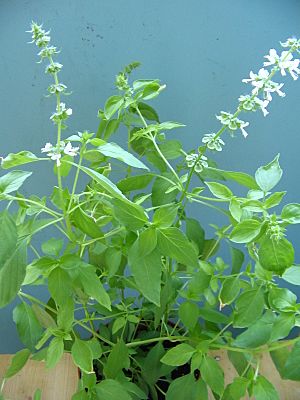Lemon basil facts for kids
Quick facts for kids Lemon basil |
|
|---|---|
 |
|
| Scientific classification | |
| Synonyms | |
|
Lemon basil is a special kind of herb known for its fresh lemon smell. You might also hear it called hoary basil, Thai lemon basil, or Lao basil. Its scientific name is Ocimum × africanum. This plant is a hybrid, meaning it's a mix of two other basil types: regular basil (Ocimum basilicum) and American basil (Ocimum americanum).
People grow lemon basil mostly in northeastern Africa and southern Asia. They love it for its strong lemon scent and use it a lot in cooking. Lemon basil plants can grow to be about 20 to 40 centimeters tall. They have pretty white flowers that bloom in late summer or early fall. The leaves look a lot like regular basil leaves. However, they are a bit narrower and have slightly jagged edges. After the flowers bloom, the plant makes seeds that dry on the plant itself.
Lemon basil is a very popular herb in many places. You'll find it in Arabic, Indonesian, Filipino, Lao, Malay, Persian, and Thai cuisine.
Contents
Cooking with Lemon Basil
Lemon basil adds a unique flavor to many dishes. It's a key ingredient in several cuisines around the world.
Lemon Basil in Asian Cooking
In Lao cuisine, lemon basil is called pak i tou. It's used a lot in soups, stews, curries, and stir-fried dishes. In fact, it's the most common type of basil used in Laos. Many Lao stews, like the popular or lam, need lemon basil. Other basil types just won't do!
In Indonesian cuisine, lemon basil is known as kemangi. It's often eaten fresh with salads or lalap (raw vegetables). People usually enjoy it with sambal, a spicy chili sauce. Lemon basil also flavors many Indonesian dishes. These include curries, soups, stews, and steamed or grilled foods.
In Thailand, lemon basil is called maenglak (Thai: แมงลัก). It's one of several basil types used in Thai cuisine. Its leaves are added to certain Thai curries. It's also a must-have for the noodle dish called khanom chin nam ya.
In the Philippines, especially in Cebu and parts of Mindanao, it's called sangig. People use it to flavor law-uy. This is a vegetable-based soup with different local greens.
Lemon Basil Seeds in Desserts
The seeds of lemon basil look a bit like chia seeds after they soak in water. They become soft and jelly-like. Because of this, they are often used in sweet desserts.
Lemon Basil in Indian Cuisine
In the North East part of India, especially in Manipur, lemon basil is used in pumpkin curries. It's also an ingredient in singju, which is a type of salad. You can also find it in red or green chili pickles.
The Garo, Khasi, and Jaintia tribes in Meghalaya also use lemon basil in their cooking. The Garos call it panet. They use it to make a cold sauce, similar to chutney. This sauce often includes fermented fish, chili, onions, and sometimes roasted tomatoes. In Tripura, it's known as banta. The Tripuri community uses it to make banta mosdeng, a spicy chutney made with fermented fish.
Growing Lemon Basil
Growing lemon basil is similar to growing other types of basil. It's a tropical plant, so it loves warm weather.
Sunlight and Water Needs
Lemon basil needs a sunny spot. It should get at least six hours of direct sunlight every day. This plant is quite tough and can sometimes grow with just water. However, for the best flavor, it needs some fertilizer, either chemical or organic. It can grow very quickly, sometimes in just a few weeks! You should water it when the top layer of soil feels dry. If the plant looks a bit droopy, it probably needs water. It will perk up quickly once watered.
Harvesting and Plant Care
To keep your basil plant healthy and bushy, you should harvest its leaves regularly. If you let the plant flower, its flavor won't be as strong. The leaves might also become smaller and tougher. So, it's a good idea to remove any flower clusters as soon as they appear. This helps the plant focus its energy on growing more leaves.
However, if you want to collect seeds for next year, you can let some plants flower. Basil plants usually die when the cold winter frosts arrive. So, you can collect the seeds about two weeks before the last frost. Then, you can plant them indoors in the spring to start new plants.
Harvesting your lemon basil once a week will make it grow bushier. This is because new shoots will grow from the sides. Make sure you don't remove all the leaves from the plant at once.
Plant Reproduction
You can grow new lemon basil plants in two ways: from seeds or from stem cuttings.
Growing from Seeds
Seedlings will grow to about 15 centimeters (6 inches) in 3 to 4 weeks. At this point, you should harvest them to encourage them to branch out.
Growing from Cuttings
To grow from stem cuttings, you can simply place basil stems in water. They will start to grow roots after about a week. A simple way to do this is to use a Mason jar filled with water. You can use a piece of mesh with holes to hold the stems in place while the roots grow. You can plant as many cuttings as you like, but the strongest stems usually root faster. Remember to change the water every few days. After 2 to 3 weeks, the roots will be long enough. Then, you can plant your new basil plants in pots or directly in your garden.
See also
 In Spanish: Albahaca de limón para niños
In Spanish: Albahaca de limón para niños

